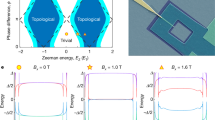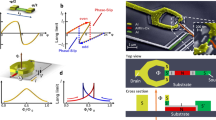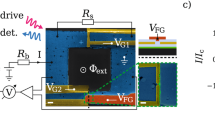Abstract
All physical implementations of quantum bits (or qubits, the logical elements in a putative quantum computer) must overcome conflicting requirements: the qubits should be manipulable through external signals, while remaining isolated from their environment. Proposals based on quantum optics emphasize optimal isolation1,2,3, while those following the solid-state route exploit the variability and scalability of nanoscale fabrication techniques4,5,6,7,8. Recently, various designs using superconducting structures have been successfully tested for quantum coherent operation9,10,11, however, the ultimate goal of reaching coherent evolution over thousands of elementary operations remains a formidable task. Protecting qubits from decoherence by exploiting topological stability is a qualitatively new proposal12 that holds promise for long decoherence times, but its physical implementation has remained unclear. Here we show how strongly correlated systems developing an isolated twofold degenerate quantum dimer liquid ground state can be used in the construction of topologically stable qubits; we discuss their implementation using Josephson junction arrays. Although the complexity of their architecture challenges the technology base available today, such topological qubits greatly benefit from their built-in fault-tolerance.
This is a preview of subscription content, access via your institution
Access options
Subscribe to this journal
Receive 51 print issues and online access
$199.00 per year
only $3.90 per issue
Buy this article
- Purchase on Springer Link
- Instant access to full article PDF
Prices may be subject to local taxes which are calculated during checkout




Similar content being viewed by others
References
Cirac, J. I. & Zoller, P. Quantum computations with cold trapped ions. Phys. Rev. Lett. 74, 4091–4094 (1995).
Monroe, C., Meekhof, D., King, B., Itano, W. & Wineland, D. Demonstration of a fundamental quantum logic gate. Phys. Rev. Lett. 75, 4714–4717 (1995).
Turchette, Q., Hood, C., Lange, W., Mabushi, H. & Kimble, H. J. Measurement of conditional phase shifts for quantum logics. Phys. Rev. Lett. 75, 4710–4713 (1995).
Loss, D. & DiVincenzo, D. P. Quantum computation with quantum dots. Phys. Rev. A 57, 120–126 (1998).
Shnirman, A., Schön, G. & Hermon, Z. Quantum manipulations of small Josephson junctions. Phys. Rev. Lett. 79, 2371–2374 (1997).
Averin, D. V. Adiabatic quantum computation with Cooper pairs. Solid State Commun. 105, 659–664 (1998).
Mooij, J. E. et al. Josephson persistent-current qubit. Science 285, 1036–1039 (1999).
Ioffe, L., Geshkenbein, V. B., Feigel'man, M. V., Fauchère, A. L. & Blatter, G. Environmentally decoupled s-wave–d-wave–s-wave Josephson junctions for quantum computing. Nature 398, 678–681 (1999).
Nakamura, Y., Pashkin, Yu. A. & Tsai, J. S. Coherent control of macroscopic quantum states in a single-Cooper-pair box. Nature 398, 786–788 (1999).
Friedman, J. R., Patel, V., Chen, W., Tolpygo, S. K. & Lukens, J. E. Quantum superposition of distinct macroscopic states. Nature 406, 43–46 (2000).
van der Wal, C. H. et al. Quantum superposition of macroscopic persistent-current states. Science 290, 773–777 (2000).
Kitaev, A. Yu. Fault-tolerant quantum computation by anyons. Preprint quant-ph/9707021 at 〈http://xxx.lanl.gov/〉 (1997).
Preskill, J. in Introduction to Quantum Computation and Information (eds Lo, H.-K., Popescu, S. & Spiller, T.) 213–269 (World Scientific, Singapore, 1998).
Kivelson, S. A., Rokhsar, D. S. & Sethna, J. P. Topology of the resonating valence-bond state: solitons and high-Tc superconductivity. Phys. Rev. B 35, 8865–8868 (1987).
Rokhwar, D. S. & Kivelson, S. A. Superconductivity and the quantum hard-core dimer gas. Phys. Rev. Lett. 61, 2376–2379 (1988).
Wen, X. G. Mean-field theory of spin-liquid states with finite energy gap and topological orders. Phys. Rev. B 44, 2664–2672 (1991).
Ioffe, L. B. & Larkin, A. I. Superconductivity in the liquid-dimer valence-bond state. Phys. Rev. B 40, 6941–6947 (1989).
Anderson, P. W. The resonating valence bond state in La2CuO4 and superconductivity. Science 235, 1196–1198 (1987).
Moessner, R. & Sondhi, S. L. Resonating valence bond phase in the triangular lattice quantum dimer model. Phys. Rev. Lett. 86, 1881–1884 (2001).
Misguich, G., Lhuillier, C., Bernu, B. & Waldtmann, C. Spin-liquid phase of the multiple-spin exchange Hamiltonian on the triangular lattice. Phys. Rev. B 60, 1064–1074 (1999).
Sachdev, S. Kagome-acute- and triangular-lattice Heisenberg antiferromagnets. Phys. Rev. B 45, 12377–12396 (1992).
Grabert, H. & Devoret, M. H. Single Charge Tunneling: Coulomb Blockade Phenomena in Nanostructures (Plenum, New York, 1992).
Fradkin, E. Field Theories of Condensed Matter Systems (Addison-Wesley, Redwood City, 1991).
Moessner, R., Sondhi, S. L. & Fradkin, E. Short-ranged RVB physics, quantum dimer models and Ising gauge theories. Preprint cond-mat/0103396 at 〈http://xxx.lanl.gov/〉 (2001).
Fradkin, E. & Shenker, S. H. Phase diagrams of lattice gauge theories with Higgs fields. Phys. Rev. D 19, 3682 (1979).
Acknowledgements
We thank V. Geshkenbein for discussions. We acknowledge financial support through the SCOPES programme (Swiss Federal Department of Foreign Affairs and Swiss National Foundation), the Dutch Organization for Fundamental Research (NWO), the Russian Foundation for Basic Research, the programme ‘Quantum Macrophysics’ of the Russian Academy of Science, and the Russian Ministry of Science. Computations were carried out on the Beowulfcluster Asgard at ETHZ.
Author information
Authors and Affiliations
Corresponding author
Rights and permissions
About this article
Cite this article
Ioffe, L., Feigel'man, M., Ioselevich, A. et al. Topologically protected quantum bits using Josephson junction arrays. Nature 415, 503–506 (2002). https://doi.org/10.1038/415503a
Received:
Accepted:
Issue Date:
DOI: https://doi.org/10.1038/415503a
This article is cited by
-
Spin-lattice decoupling in a triangular-lattice quantum spin liquid
Nature Communications (2018)
-
Majorana fermions in the nonuniform Ising-Kitaev chain: exact solution
Scientific Reports (2017)
-
A two-dimensional spin liquid in quantum kagome ice
Nature Communications (2015)
-
Design and synthesis of the first triply twisted Möbius annulene
Nature Chemistry (2014)
-
Destroying a topological quantum bit by condensing Ising vortices
Nature Communications (2014)
Comments
By submitting a comment you agree to abide by our Terms and Community Guidelines. If you find something abusive or that does not comply with our terms or guidelines please flag it as inappropriate.



